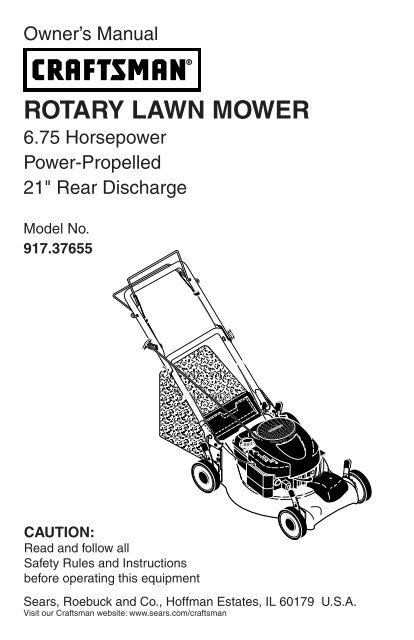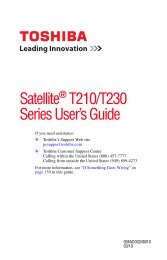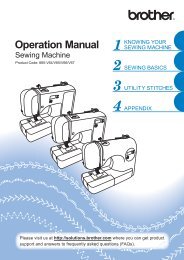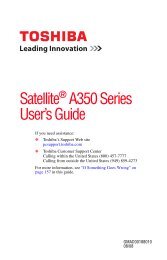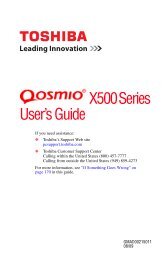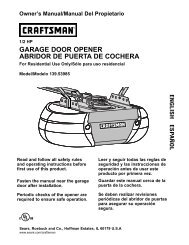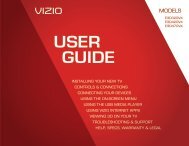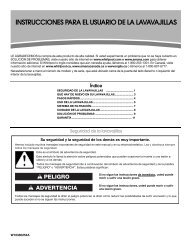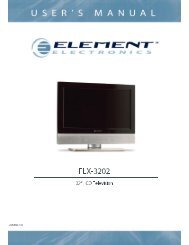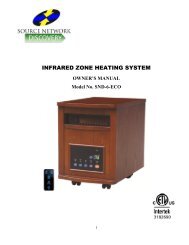ROTARY LAWN MOWER - Sears
ROTARY LAWN MOWER - Sears
ROTARY LAWN MOWER - Sears
Create successful ePaper yourself
Turn your PDF publications into a flip-book with our unique Google optimized e-Paper software.
Owner’s Manual<br />
<strong>ROTARY</strong> <strong>LAWN</strong> <strong>MOWER</strong><br />
6.75 Horsepower<br />
Power-Propelled<br />
21" Rear Discharge<br />
Model No.<br />
917.37655<br />
CAUTION:<br />
Read and follow all<br />
Safety Rules and In struc tions<br />
before operating this equipment<br />
<strong>Sears</strong>, Roebuck and Co., Hoffman Estates, IL 60179 U.S.A.<br />
Visit our Craftsman website: www.sears.com/craftsman
Warranty ...................................................2<br />
Safe ty Rules ..........................................2-4<br />
Prod uct Spec i fi ca tions..............................4<br />
Assembly / Pre-Operation ........................6<br />
Op er a tion.............................................7-10<br />
Maintenance Sched ule...........................11<br />
TABLE OF CONTENTS<br />
WARRANTY<br />
SAFETY RULES<br />
2<br />
Maintenance......................................11-14<br />
Ser vice and Ad just ments...................14-15<br />
Stor age..............................................15-16<br />
Trou ble shoot ing .................................16-17<br />
<strong>Sears</strong> Service .......................... Back Cov er<br />
LIMITED TWO YEAR WARRANTY ON CRAFTS MAN POWER <strong>MOWER</strong><br />
For two years from date of purchase, when this Crafts man Lawn Mower is maintained,<br />
lubricated, and tuned up according to the operating and maintenance in struc tions in the<br />
owner’s manual, <strong>Sears</strong> will repair free of charge any defect in material or work man ship.<br />
If this Craftsman Lawn Mower is used for commercial or rental purposes, this warranty<br />
applies for only 90 days from the date of purchase.<br />
This Warranty does not cover:<br />
Expendable items which become worn during normal use, such as rotary mower<br />
blades, blade adapters, belts, air cleaners and spark plug.<br />
Repairs necessary because of operator abuse or neg li gence, including bent crankshafts<br />
and the failure to main tain the equipment according to the instructions contained<br />
in the owner’s manual.<br />
Warranty service is available by re turn ing the Craftsman power mower to the near est <strong>Sears</strong><br />
Parts & Repair Center in the United States. This war ran ty ap plies only while this product<br />
is used in the United States.<br />
This Warranty gives you specifi c legal rights, and you may also have other rights which<br />
vary from state to state.<br />
<strong>Sears</strong>, Roebuck And Co., D/817 WA, Hoffman Estates, IL 60179<br />
IMPORTANT: This cutting machine is capable of amputating hands and feet and throwing<br />
objects. Failure to observe the following safety instructions could result in serious<br />
injury or death.<br />
Look for this symbol to point out<br />
im por tant safety precautions. It means<br />
CAU TION!!! BECOME ALERT!!!<br />
YOUR SAFE TY IS INVOLVED.<br />
WARNING: In order to prevent acci<br />
den tal starting when setting up, transport<br />
ing, ad just ing or making repairs,<br />
always dis con nect spark plug wire and<br />
place wire where it can not come in contact<br />
with plug.<br />
WARNING: Engine exhaust, some of its<br />
constituents, and certain vehicle com po -<br />
nents contain or emit chem i cals known<br />
to the State of Cal i for nia to cause can cer<br />
and birth defects or oth er re pro duc tive<br />
harm.<br />
WARNING: Battery posts, terminals and<br />
related accessories contain lead and lead<br />
compounds, chemicals known to the State<br />
of Cal i for nia to cause can cer and birth<br />
defects or oth er re pro duc tive harm. Wash<br />
hands after handling.<br />
CAUTION: Muffl er and other engine<br />
parts become extremely hot during<br />
operation and remain hot after engine has<br />
stopped. To avoid severe burns on contact,<br />
stay away from these areas.
I. GENERAL OPERATION<br />
Read, understand, and follow all<br />
in struc tions on the machine and in the<br />
manual(s) before starting. Be thor ough ly<br />
familiar with the controls and the proper<br />
use of the machine before starting.<br />
Do not put hands or feet near or under<br />
rotating parts. Keep clear of the discharge<br />
opening at all times.<br />
Only allow responsible individuals, who<br />
are familiar with the in struc tions, to operate<br />
the machine.<br />
Clear the area of objects such as rocks,<br />
toys, wire, bones, sticks, etc., which<br />
could be picked up and thrown by blade.<br />
Be sure the area is clear of other people<br />
before mowing. Stop ma chine if anyone<br />
enters the area.<br />
Do not operate the mower when barefoot<br />
or wearing open sandals. Al ways<br />
wear substantial foot wear.<br />
Do not pull mower backwards unless<br />
absolutely nec es sary. Always look down<br />
and behind before and while moving<br />
backwards.<br />
Never direct discharged material toward<br />
anyone. Avoid discharging material<br />
against a wall or obstruction. Material<br />
may richochet back toward the operator.<br />
Stop the blade when crossing gravel<br />
surfaces.<br />
Do not operate the mower without<br />
proper guards, plates, grass catcher or<br />
oth er safety protective devices in place.<br />
See manufacturer’s instructions for<br />
proper operation and installation of<br />
accessories. Only use accessories approved<br />
by the manufacturer.<br />
Stop the blade(s) when crossing grav el<br />
drives, walks, or roads.<br />
Stop the engine (motor) whenever you<br />
leave the equip ment, before clean ing the<br />
mower or unclogging the chute.<br />
Shut the engine (motor) off and wait until<br />
the blade comes to complete stop before<br />
removing grass catcher.<br />
Mow only in daylight or good artifi cial<br />
light.<br />
Do not operate the machine while under<br />
the infl uence of alcohol or drugs.<br />
Never operate machine in wet grass.<br />
Always be sure of your footing: keep a<br />
fi rm hold on the handle; walk, never run.<br />
Disengage the self-propelled mecha<br />
nism or drive clutch on mowers so<br />
equipped before starting the engine.<br />
If the equipment should start to vi brate<br />
abnormally, stop the engine (motor) and<br />
check immediately for the cause. Vibration<br />
is generally a warning of trouble.<br />
3<br />
Always wear safety goggles or safe ty<br />
glasses with side shields when op er at ing<br />
mower.<br />
II. SLOPE OPERATION<br />
Slopes are a major factor related to slip &<br />
fall accidents which can result in severe injury.<br />
All slopes require extra caution. If you<br />
feel uneasy on a slope, do not mow it.<br />
DO:<br />
Mow across the face of slopes: nev er<br />
up and down. Exercise extreme caution<br />
when changing direction on slopes.<br />
Remove obstacles such as rocks, tree<br />
limbs, etc.<br />
Watch for holes, ruts, or bumps. Tall<br />
grass can hide obstacles.<br />
DO NOT:<br />
Do not trim near drop-offs, ditches or<br />
embankments. The operator could lose<br />
footing or balance.<br />
Do not trim excessively steep slopes.<br />
Do not mow on wet grass. Reduced footing<br />
could cause slipping.<br />
III. CHILDREN<br />
Tragic accidents can occur if the op er a tor<br />
is not alert to the presence of children.<br />
Children are often attracted to the ma chine<br />
and the mowing activity. Never assume<br />
that children will remain where you last<br />
saw them.<br />
Keep children out of the trimming area<br />
and under the watchful care of an oth er<br />
re spon si ble adult.<br />
Be alert and turn machine off if chil dren<br />
enter the area.<br />
Before and while walking back wards,<br />
look behind and down for small chil dren.<br />
Never allow children to operate the machine.<br />
Use extra care when approaching blind<br />
corners, shrubs, trees, or other objects<br />
that may obscure vision.<br />
IV. SAFE HANDLING OF GASOLINE<br />
Use extreme care in handling gasoline.<br />
Gasoline is extremely fl ammable and the<br />
vapors are explosive.<br />
Extinguish all cigarettes, cigars, pipes<br />
and other sources of ignition.<br />
Use only an approved container.<br />
Never remove gas cap or add fuel with<br />
the engine running. Allow engine to cool<br />
before refueling.<br />
Never refuel the machine indoors.<br />
Never store the machine or fuel container<br />
where there is an open fl ame, spark<br />
or pilot light such as a water heater or on<br />
other appliances.
Never fi ll containers inside a vehicle, on<br />
a truck or trailer bed with a plastic liner.<br />
Always place containers on the ground<br />
away from your vehicle before fi lling.<br />
Remove gas-powered equipment from<br />
the truck or trailer and refuel it on the<br />
ground. If this is not possible, then<br />
refuel such equipment with a portable<br />
container, rather than from a gasoline<br />
dispenser nozzle.<br />
Keep the nozzle in contact with the rim<br />
of the fuel tank or container opening at<br />
all times until fueling is complete. Do<br />
not use a nozzle lock-open device.<br />
If fuel is spilled on clothing, change<br />
clothing immediately.<br />
Never overfi ll fuel tank. Replace gas<br />
cap and tighten securely.<br />
V. GENERAL SERVICE<br />
Never run a machine inside a closed<br />
area.<br />
Never make adjustments or repairs with<br />
the engine (motor) running. Dis con nect<br />
the spark plug wire, and keep the wire<br />
away from the plug to prevent ac ci den tal<br />
starting.<br />
4<br />
Keep nuts and bolts, especially blade<br />
attachment bolts, tight and keep equipment<br />
in good condition.<br />
Never tamper with safety devices. Check<br />
their proper operation reg u lar ly.<br />
Keep machine free of grass, leaves, or<br />
other debris build-up. Clean oil or fuel<br />
spillage. Allow machine to cool before<br />
storing.<br />
Stop and inspect the equipment if you<br />
strike an object. Repair, if nec es sary,<br />
before restarting.<br />
Never attempt to make wheel height<br />
adjustments while the engine is running.<br />
Grass catcher components are sub ject<br />
to wear, dam age, and de te ri o ra tion,<br />
which could expose moving parts or<br />
allow objects to be thrown. Frequently<br />
check com po nents and replace with<br />
man u fac tur er’s recommended parts,<br />
when necessary.<br />
Mower blades are sharp and can cut.<br />
Wrap the blade(s) or wear gloves, and<br />
use extra caution when ser vic ing them.<br />
Do not change the engine governor setting<br />
or overspeed the engine.<br />
Maintain or replace safety and instruction<br />
labels, as necessary.<br />
WARNING: This lawn mower is equipped with an internal com bus tion engine and<br />
should not be used on or near any un im proved forest-covered, brush-covered or<br />
grass-cov ered land unless the engine’s exhaust system is equipped with a spark<br />
arrester meeting applicable local or state laws (if any). If a spark arrester is used, it<br />
should be maintained in effective working order by the operator.<br />
In the state of California the above is required by law (Section 4442 of the California<br />
Public Resources Code). Other states may have similar laws. Federal laws apply on<br />
federal lands. A spark arrester for the muffl er is available through your nearest <strong>Sears</strong><br />
Parts & Repair Center (See the REPAIR PARTS section of this manual).<br />
PRODUCT SPECIFICATIONS<br />
Serial Number:<br />
Date of Purchase:<br />
Gasoline Capacity / Type: 1.6 Quarts (Unleaded Regular)<br />
Oil Capacity: 20 Ounces<br />
Oil Type (API SG–SL): SAE 30 (above 32°F); SAE 5W-30 (below 32°F)<br />
Spark Plug: Champion RJ19HX (Gap: .030")<br />
Blade Bolt Torque: 35-40 ft. lbs.<br />
The model and serial numbers will be found on a decal on the rear of the lawn mower<br />
housing. Record both serial number and date of purchase in space provided above.
Congratulations on making a smart purchase.<br />
Your new Craftsman® product is<br />
designed and manufactured for years of<br />
dependable operation. But like all products,<br />
it may require repair from time to<br />
time. That’s when having a Repair Protection<br />
Agreement can save you money and<br />
aggravation.<br />
Purchase a Repair Protection Agreement<br />
now and protect yourself from unexpected<br />
hassle and expense.<br />
Here’s what’s included in the Agreement:<br />
Expert service by our 12,000 profesional<br />
repair specialists.<br />
Unlimited service and no charge for<br />
parts and labor on all covered repairs.<br />
Product replacement if your covered<br />
product can’t be fi xed.<br />
Discount of 10% from regular price of<br />
service and service-related parts not<br />
covered by the agreement; also, 10%<br />
off regular price of preventive maintenance<br />
check.<br />
Repair Protection Agreements<br />
ACCESSORIES<br />
These accessories were available when this lawn mower was produced. They are not<br />
shipped with your mower. They are also available at most <strong>Sears</strong> retail outlets and<br />
service centers. Some of these accessories may not apply to your lawn mower.<br />
5<br />
Fast help by phone – phone support<br />
from a <strong>Sears</strong> technician on products<br />
requiring in-home repair, plus convenient<br />
repair scheduling.<br />
Once you purchase the Agreement, a<br />
simple phone call is all that it takes for you<br />
to schedule service. You can call anytime<br />
day or night, or schedule a service appointment<br />
online.<br />
<strong>Sears</strong> has over 12,000 professional repair<br />
specialists, who have access to over 4.5<br />
million quality parts and accessories.<br />
That’s the kind of professionalism you can<br />
count on to help prolong the life of your<br />
new purchase for years to come. Purchase<br />
your Repair Protection Agreement today!<br />
Some limitations and exclusions apply.<br />
For prices and additional information<br />
call 1-800-827-6655.<br />
<strong>Sears</strong> Installation Service<br />
For <strong>Sears</strong> professional installation of home<br />
appliances, garage door openers, water<br />
heaters, and other major home items, in<br />
the U.S.A. call 1-800-4-MY-HOME®.
Read these instructions and this manual in<br />
its entirety before you attempt to assemble<br />
or operate your new lawn mower.<br />
IMPORTANT: This lawn mower is shipped<br />
WITHOUT OIL OR GASOLINE in the engine.<br />
Your new lawn mower has been assem<br />
bled at the factory with the exception<br />
of those parts left unassembled for<br />
shipping pur pos es. To ensure safe and<br />
proper op er a tion of your lawn mower, all<br />
parts and hard ware you assemble must be<br />
tight ened securely. Use the correct tools<br />
as nec es sary to ensure proper tightness.<br />
All parts such as nuts, wash ers, bolts, etc.,<br />
nec es sary to complete the as sem bly have<br />
been placed in the parts bag.<br />
TO REMOVE <strong>LAWN</strong> <strong>MOWER</strong> FROM<br />
CARTON<br />
1. Remove loose parts included with<br />
mower.<br />
2. Cut down two end corners of carton<br />
and lay end panel down fl at.<br />
3. Remove all packing materials except<br />
padding be tween upper and lower<br />
handle and padding holding operator<br />
presence control bar to upper handle.<br />
4. Roll lawn mower out of carton and<br />
check carton thor ough ly for additional<br />
loose parts.<br />
HOW TO SET UP YOUR <strong>LAWN</strong><br />
MOW ER<br />
TO UNFOLD HANDLE<br />
IMPORTANT: Unfold handle carefully so<br />
as not to pinch or damage con trol cables.<br />
1. Raise handles until lower handle section<br />
locks into place in mowing position.<br />
2. Remove protective padding, raise upper<br />
handle sec tion into place on lower<br />
handle and tighten both handle knobs.<br />
3. Remove handle padding holding<br />
operator pres ence control bar to upper<br />
handle.<br />
Your lawn mower handle can be adjusted<br />
for your mowing comfort. Refer to “AD-<br />
JUST HANDLE” in the Service and Adjustments<br />
section of this manual.<br />
ASSEMBLY / PRE-OPERATION<br />
6<br />
Operator<br />
presence<br />
control bar<br />
LIFT<br />
UP<br />
TO ASSEMBLE GRASS CATCH ER<br />
1. Put grass catcher frame into grass bag<br />
with rigid part of bag on the bottom.<br />
Make sure the frame handle is outside<br />
of the bag top.<br />
2. Slip vinyl bindings over frame.<br />
NOTE: If vinyl bindings are too stiff, hold<br />
them in warm water for a few minutes. If<br />
bag gets wet, let it dry before using.<br />
Vinyl<br />
bindings<br />
LIFT<br />
UP<br />
MOWING<br />
POSITION<br />
Upper<br />
handle<br />
Handle<br />
knob<br />
Lower handle<br />
Frame<br />
handle<br />
Frame<br />
opening<br />
TO INSTALL ATTACHMENTS<br />
Your lawn mower was shipped ready to be<br />
used as a mulcher. To convert mower to<br />
bagging or discharging, see “TO CON-<br />
VERT <strong>MOWER</strong>” in the Operation section<br />
of this manual.
KNOW YOUR <strong>LAWN</strong> <strong>MOWER</strong><br />
READ THIS OWNER'S MANUAL AND ALL SAFETY RULES BEFORE OP ER AT ING<br />
YOUR <strong>LAWN</strong> <strong>MOWER</strong>. Compare the illustrations with your lawn mower to familiarize<br />
yourself with the location of various controls and adjustments. Save this manual for<br />
future reference.<br />
These symbols may appear on your lawn mower or in literature supplied with the<br />
product. Learn and understand their meaning.<br />
Drive<br />
control<br />
bar<br />
Starter<br />
handle<br />
Grass<br />
catcher<br />
Gasoline fi ller cap<br />
Air fi lter<br />
Wheel adjuster (on each wheel)<br />
Operator presence control bar<br />
Handle knob<br />
Engine oil cap with dipstick<br />
IMPORTANT: This lawn mower is shipped WITHOUT OIL OR GASOLINE in the engine.<br />
MEETS CPSC SAFETY REQUIREMENTS<br />
<strong>Sears</strong> rotary walk-behind power lawn mowers conform to the safety standards of the<br />
American National Standards Institute and the U.S. Consumer Product Safety Commis<br />
sion. The blade turns when the engine is running.<br />
Operator presence control bar – must<br />
be held down to the handle to start the<br />
engine. Release to stop the engine.<br />
Drive control bar – used to engage<br />
power-pro pelled forward mo tion of mower.<br />
OPERATION<br />
Primer<br />
Spark plug<br />
Muffl er<br />
Housing<br />
Drive<br />
cover<br />
Starter handle – used for starting engine.<br />
Primer – pumps additional fuel from the<br />
carburetor to the cylinder for use when<br />
starting a cold engine.<br />
7
The operation of any lawn<br />
mower can result in foreign<br />
objects thrown into the<br />
eyes, which can result in<br />
severe eye damage. Always<br />
wear safety glasses or eye shields while<br />
operating your lawn mower or performing<br />
any ad just ments or repairs. We recommend<br />
a standard safety glasses or wide<br />
vision safety mask worn over spectacles.<br />
HOW TO USE YOUR <strong>LAWN</strong> <strong>MOWER</strong><br />
ENGINE SPEED<br />
The engine speed was set at the factory<br />
for optimum performance. Speed is not<br />
adjustable.<br />
ENGINE ZONE CONTROL<br />
CAUTION: Federal regulations re quire<br />
an engine control to be installed on this<br />
lawn mower in order to minimize the<br />
risk of blade contact injury. Do not un der<br />
any circumstances attempt to de feat the<br />
func tion of the operator con trol. The blade<br />
turns when the engine is running.<br />
Your lawn mower is equipped with an<br />
operator pres ence control bar which<br />
requires the operator to be positioned<br />
behind the lawn mower handle to start<br />
and operate the lawn mower.<br />
TO OPERATE DRIVE SYSTEM<br />
To start forward motion, lift drive control<br />
bar up to handle.<br />
To stop forward motion, release drive<br />
control bar.<br />
IMPORTANT: Always keep drive control<br />
fully engaged against handle when in use.<br />
Operator pres ence con trol bar<br />
DRIVE<br />
CONTROL<br />
ENGANGED<br />
DRIVE<br />
CONTROL<br />
DIS EN GAGED<br />
TO ADJUST CUTTING HEIGHT<br />
Raise wheels for low cut and lower wheels<br />
for high cut, adjust cutting height to suit<br />
your requirements. Me di um position is<br />
best for most lawns.<br />
To change cutting height, squeeze adjuster<br />
lever to ward wheel. Move wheel<br />
up or down to suit your re quire ments. Be<br />
sure all wheels are in the same setting.<br />
NOTE: Adjuster is properly positioned<br />
when plate tab inserts into hole in lever.<br />
8<br />
Also, 9-position adjusters (if so equipped)<br />
allow lever to be positioned between the<br />
plate tabs.<br />
LEVER BACKWARD<br />
TO LOWER <strong>MOWER</strong><br />
Plate tab<br />
LEVER FORWARD TO RAISE <strong>MOWER</strong><br />
Lever<br />
TO CONVERT <strong>MOWER</strong><br />
Your lawn mower was shipped ready to be<br />
used as a mulcher. To convert to bagging:<br />
Lift rear door of the lawn mower and<br />
place the grass catcher frame hooks<br />
onto the door pivot pins.<br />
To convert to mulching operation, remove<br />
grass catcher and close rear door.<br />
CAUTION: Do not run your lawn mower<br />
without rear door closed, clipping de fl ec tor<br />
or ap proved grass catch er in place. Nev er<br />
at tempt to operate the lawn mower with<br />
the rear door removed or propped open.<br />
Pivot pins Rear Grass<br />
door catcher<br />
handle<br />
Catcher frame hook<br />
TO EMPTY GRASS CATCHER<br />
1. Lift up on grass catcher using the<br />
frame han dle.<br />
2. Remove grass catcher with clippings<br />
from under lawn mower han dle.<br />
3. Empty clippings from bag.<br />
NOTE: Do not drag the bag when emptying;<br />
it will cause unnecessary wear.<br />
Grass<br />
catcher<br />
frame<br />
handle
BEFORE STARTING ENGINE<br />
ADD OIL<br />
Your lawnmower is shipped without oil in<br />
the engine. For type and grade of oil to<br />
use, see “EN GINE” in the Maintenance<br />
section of this manual.<br />
CAUTION: DO NOT overfi ll engine with<br />
oil, or it will smoke heavily from the muffl er<br />
on startup.<br />
1. Be sure lawnmower is level.<br />
2. Remove oil dipstick from oil fi ll spout.<br />
3. You receive a container of oil with the<br />
unit. Slowly pour the entire container<br />
down the oil fi ll spout into the engine.<br />
NOTE: Initial oil fi ll requires only 18 oz.<br />
due to residual oil in engine from the<br />
manufacturers 100% quality testing. When<br />
changing oil you may need 20 oz.<br />
4. Insert and tighten dipstick.<br />
IMPORTANT:<br />
Check oil level before each use. Add oil<br />
if needed. Fill to full line on dipstick.<br />
Change the oil after every 25 hours of<br />
operation or each season. You may<br />
need to change the oil more often<br />
under dusty, dirty conditions. See “TO<br />
CHANGE ENGINE OIL” in the Maintenance<br />
section of this manual.<br />
ATTACH FUEL CAP CARTRIDGE<br />
Your mower is equipped with a special<br />
FRESH START TM fuel cap and continuous<br />
fuel preserver cartridge. See the information<br />
and instructions packed with the<br />
FRESH START TM cartridge.<br />
1. Snap cartridge into bottom of fuel cap.<br />
NOTE: Do not remove the silver foil seal<br />
on the side of cartridge that snaps into<br />
fuel cap.<br />
2. Grasp the white peel tab and pull to<br />
remove the entire seal.<br />
3. Screw fuel cap onto fuel tank after fi lling<br />
tank with gasoline.<br />
Replace cartridge when empty (about<br />
once a season). Check preserver level<br />
visually.<br />
DANGER: Cartridge fl uid is HARMFUL<br />
OR FATAL IF SWALLOWED. Avoid contact<br />
to eyes, skin, or clothing. Do not take<br />
internally. Do not inhale fl uid vapor. Keep<br />
out of reach of children. If swallowed, call<br />
a physician immediately.<br />
ADD GASOLINE<br />
Fill fuel tank to bottom of tank fi ller neck.<br />
Do not overfi ll. Use fresh, clean, regular<br />
unleaded gasoline with a minimum of<br />
87 octane. Do not mix oil with gasoline.<br />
Purchase fuel in quan ti ties that can be<br />
used within 30 days to assure fuel freshness.<br />
9<br />
Gasoline<br />
fi ller cap<br />
Primer<br />
Engine<br />
oil cap<br />
CAUTION: Wipe off any spilled oil or<br />
fuel. Do not store, spill or use gasoline<br />
near an open fl ame.<br />
CAUTION: Alcohol blended fuels<br />
(called gasohol or using ethanol or methanol)<br />
can attract moisture which leads to<br />
separation and for ma tion of acids during<br />
storage. Acidic gas can damage the fuel<br />
system of an engine while in storage. To<br />
avoid engine problems, the fuel system<br />
should be emptied before stor age of 30<br />
days or longer. Empty the gas tank, start<br />
the engine and let it run until the fuel lines<br />
and carburetor are empty. Use fresh fuel<br />
next season. See Storage In struc tions for<br />
additional information. Never use engine<br />
or carburetor cleaner products in the fuel<br />
tank or permanent damage may occur.<br />
TO STOP ENGINE<br />
To stop engine, release operator presence<br />
con trol bar.<br />
TO START ENGINE<br />
NOTE: Due to protective coatings on the<br />
engine, a small amount of smoke may be<br />
present during the initial use of the product<br />
and should be considered normal.<br />
1. To start a cold engine, push primer<br />
three (3) times before trying to start.<br />
Use a fi rm push. This step is not<br />
usually necessary when starting an<br />
engine which has already run for a few<br />
minutes.<br />
2. Hold operator presence control bar<br />
down to the han dle and pull starter<br />
handle quickly. Do not allow starter<br />
rope to snap back.<br />
NOTE: In cooler weather it may be necessary<br />
to repeat priming steps. In warmer<br />
weather over priming may cause fl ooding<br />
and engine will not start. If you do fl ood<br />
engine, wait a few minutes before attempting<br />
to start and do not repeat priming<br />
steps.
MOWING TIPS<br />
CAUTION: Do not use de-thatcher<br />
blade attachments on your mower. Such<br />
attachments are hazardous, will damage<br />
your mower and could void your warranty.<br />
CAUTION: Use only the replacement<br />
blade shown in the Repair Parts section of<br />
this manual. Using a blade not approved<br />
by the manufacturer of your mower is<br />
hazardous, will damage your mower and<br />
could void your warranty.<br />
Under certain conditions, such as very<br />
tall grass, it may be nec es sary to raise<br />
the height of cut to reduce pushing<br />
effort and to keep from overloading the<br />
engine and leaving clumps of grass clippings.<br />
It may also be necessary to reduce<br />
ground speed and/or run the lawn<br />
mower over the area a sec ond time.<br />
For extremely heavy cutting, re duce the<br />
width of cut by over lap ping previously<br />
cut path and mow slowly.<br />
For better grass bagging and most cutting<br />
conditions, the engine speed should<br />
be set in the FAST po si tion.<br />
When using a rear discharge lawn<br />
mower in moist, heavy grass, clumps<br />
of cut grass may not enter the grass<br />
catcher. Reduce ground speed (pushing<br />
speed) and/or run the lawn mower over<br />
the area a second time.<br />
If a trail of clippings is left on the right<br />
side of a rear discharge mow er, mow in<br />
a clockwise direction with a small overlap<br />
to collect the clippings on the next<br />
pass.<br />
Pores in cloth grass catchers can become<br />
fi lled with dirt and dust with use<br />
and catchers will collect less grass. To<br />
prevent this, reg u lar ly hose catcher off<br />
with water and let dry before using.<br />
Keep top of engine around starter clear<br />
and clean of grass clippings and chaff.<br />
This will help engine air fl ow and extend<br />
engine life.<br />
10<br />
MULCHING MOWING TIPS<br />
IMPORTANT: For best performance,<br />
keep mower housing free of built-up<br />
grass and trash. See “CLEANING” in the<br />
Maintenance section of this manual.<br />
The special mulching blade will recut<br />
the grass clip pings many times and<br />
reduce them in size so that as they fall<br />
onto the lawn they will disperse into<br />
the grass and not be noticed. Also, the<br />
mulched grass will bio de grade quick ly<br />
to provide nu tri ents for the lawn. Always<br />
mulch with your highest engine (blade)<br />
speed as this will provide the best recutting<br />
action of the blades.<br />
Avoid cutting your lawn when it is wet.<br />
Wet grass tends to form clumps and<br />
in ter feres with the mulch ing action. The<br />
best time to mow your lawn is the early<br />
afternoon. At this time the grass has<br />
dried, yet the newly cut area will not be<br />
exposed to direct sunlight.<br />
For best results, adjust the lawn mower<br />
cutting height so that the lawn mower<br />
cuts off only the top one-third of the<br />
grass blades. If the lawn is over grown it<br />
will be nec es sary to raise the height of<br />
cut to reduce pushing effort and to keep<br />
from over load ing the engine and leaving<br />
clumps of mulched grass. For ex tremely<br />
heavy grass, reduce your width of cut<br />
by overlapping previously cut path and<br />
mow slowly.<br />
MAX 1/3<br />
Certain types of grass and grass<br />
con di tions may re quire that an area be<br />
mulched a second time to com pletely<br />
hide the clip pings. When doing a second<br />
cut, mow across (perpendicular) to<br />
the fi rst cut path.<br />
Change your cutting pattern from week<br />
to week. Mow north to south one week<br />
then change to east to west the next<br />
week. This will help prevent matting and<br />
graining of the lawn.
*<br />
**<br />
***<br />
****<br />
Check for Loose Fasteners<br />
Clean / Inspect Grass Catcher *<br />
Check Tires<br />
Check Drive Wheels ***<br />
Clean Lawn Mower ****<br />
Clean under Drive Cover ***<br />
Check Drive Belt / Pulleys ***<br />
Check / Sharpen / Replace Blade<br />
Lubrication<br />
Clean and Recharge Battery **<br />
Check Engine Oil level<br />
Change Engine Oil<br />
Clean Air Filter<br />
Inspect Muffler<br />
Replace Spark Plug<br />
Replace Air Filter Paper Cartridge<br />
Empty fuel system or add Stabilizer<br />
(if so equipped)<br />
Electric-Start mowers<br />
Power-Propelled mowers<br />
Use a scraper<br />
to clean under deck<br />
BEFORE<br />
EACH<br />
USE<br />
GENERAL REC OM MEN DA TIONS<br />
The warranty on this lawn mower does not<br />
cover items that have been sub ject ed to<br />
operator abuse or negligence. To receive<br />
full value from the warranty, operator must<br />
maintain unit as in struct ed in this manual.<br />
Some adjustments will need to be made<br />
periodically to properly maintain your unit.<br />
At least once a season, check to see if<br />
you should make any of the adjustments<br />
described in the Service and Ad just ments<br />
section of this manual.<br />
At least once a year, replace the spark<br />
plug, clean or replace air fi lter element<br />
and check blade for wear. A new spark<br />
plug and clean/new air fi lter element<br />
assure proper air-fuel mix ture and help<br />
your engine run bet ter and last longer.<br />
Follow the maintenance schedule in this<br />
manual.<br />
BEFORE EACH USE<br />
Check engine oil level.<br />
Check for loose fasteners.<br />
LUBRICATION<br />
Keep unit well lubricated<br />
(See “LU BRI CA TION CHART”).<br />
MAINTENANCE<br />
AFTER<br />
EACH<br />
USE<br />
EVERY<br />
10<br />
HOURS<br />
EVERY<br />
25 HOURS<br />
OR SEASON<br />
EVERY<br />
100<br />
HOURS<br />
BEFORE<br />
STORAGE<br />
1 - Change more often if operating under a heavy load or in high outdoor temperatures.<br />
2 - Service more often if operating in dirty or dusty conditions.<br />
3 - Replace blades more often when mowing in sandy soil.<br />
4 - Charge 48 hours at end of season.<br />
5 - And after each 5 hours of use.<br />
LUBRICATION CHART<br />
➀ Wheel<br />
adjuster (on<br />
each wheel)<br />
➁ Engine oil<br />
➀ Rear door<br />
hinge<br />
➀ Handle bracket mounting pins<br />
➀ Spray lubricant<br />
➁ See "ENGINE" in Maintenance section.<br />
IMPORTANT: Do not oil or grease plastic<br />
wheel bearings. Viscous lu bri cants will<br />
attract dust and dirt that will short en the life of<br />
the self-lu bri cat ing bearings. If you feel they<br />
must be lu bri cated, use only a dry, pow dered<br />
graphite type lubricant spar ingly.<br />
11
<strong>LAWN</strong> <strong>MOWER</strong><br />
Always observe safety rules when perform<br />
ing any main te nance.<br />
TIRES<br />
Keep tires free of gasoline, oil, or insect<br />
control chemi cals which can harm rubber.<br />
Avoid stumps, stones, deep ruts, sharp<br />
objects and other hazards that may<br />
cause tire damage.<br />
DRIVE WHEELS<br />
Check front drive wheels each time be fore<br />
you mow to be sure they move freely.<br />
The wheels not turning freely means<br />
trash, grass cuttings, etc. are in the drive<br />
wheel area and must be cleaned to free<br />
drive wheels.<br />
If necessary to clean the drive wheels, be<br />
sure to clean both front wheels.<br />
1. Remove hubcaps, locknuts & washers.<br />
2. Remove wheels from wheel ad just ers.<br />
3. Remove any trash or grass cuttings<br />
from inside the dust cover, pinion and/<br />
or drive wheel gear teeth.<br />
4. Put wheels back in place.<br />
NOTE: If after cleaning, the drive wheels<br />
do not turn freely, contact a <strong>Sears</strong> or other<br />
qualifi ed service center.<br />
BLADE CARE<br />
For best results, blade must be kept sharp.<br />
Re place a bent or dam aged blade.<br />
CAUTION: Use only a replacement<br />
blade approved by the manufacturer of<br />
your mower. Using a blade not approved<br />
by the manufacturer of your mower is<br />
hazardous, could damage your mower and<br />
void your warranty.<br />
TO REMOVE BLADE<br />
1. Disconnect spark plug wire from spark<br />
plug and place wire where it cannot<br />
come in contact with plug.<br />
2. Turn lawn mower on its side. Make<br />
sure air fi lter and carburetor are up.<br />
3. Use a wood block between blade and<br />
mower hous ing to prevent blade from<br />
turning when re mov ing blade bolt.<br />
NOTE: Protect your hands with gloves<br />
and/or wrap blade with heavy cloth.<br />
4. Remove blade bolt by turning counterclockwise.<br />
5. Remove blade & attaching hard ware<br />
(bolt, lock wash er & hardened wash er).<br />
TO REPLACE BLADE<br />
1. Position blade on the blade adapter<br />
aligning the two (2) holes in the blade<br />
with the raised lugs on the adapter.<br />
2. Be sure the trailing edge of blade (opposite<br />
sharp edge) is up toward the<br />
engine.<br />
12<br />
3. Install the blade bolt with the lock<br />
washer and hardened washer into<br />
blade adapter and crankshaft.<br />
4. Use block of wood between blade and<br />
lawn mower housing and tighten the<br />
blade bolt, turning clockwise.<br />
The recommended tightening torque is<br />
35-40 ft. lbs.<br />
IMPORTANT: Blade bolt is heat treated.<br />
If bolt needs replacing, replace only with<br />
approved bolt shown in the Repair Parts<br />
section of this manual.<br />
Blade adapter Key<br />
Lockwasher<br />
Blade<br />
bolt<br />
Blade<br />
Hardened<br />
washer<br />
Crankshaft<br />
keyway<br />
Trailing edge Crankshaft<br />
TO SHARPEN BLADE<br />
NOTE: We do not recommend sharp en ing<br />
the blade - but if you do, be sure the blade<br />
is balanced.<br />
Care should be taken to keep the blade<br />
balanced. An un bal anced blade will<br />
cause eventual damage to lawn mower or<br />
engine.<br />
The blade can be sharp ened with a fi le<br />
or on a grinding wheel. Do not attempt<br />
to sharpen while on the mower.<br />
To check blade balance, drive a nail into<br />
a beam or wall. Leave about one inch of<br />
the straight nail ex posed. Place center<br />
hole of blade over the head of the nail.<br />
If blade is balanced, it should remain in<br />
a horizontal position. If either end of the<br />
blade moves downward, sharpen the<br />
heavy end until the blade is balanced.<br />
GRASS CATCHER<br />
The grass catcher may be hosed with<br />
water, but must be dry when used.<br />
Check your grass catcher often for damage<br />
or de te ri o ra tion. Through normal<br />
use it will wear. If catcher needs replacing,<br />
replace only with ap proved replacement<br />
catcher shown in the Repair Parts<br />
section of this manual. Give the lawn<br />
mower model number when ordering.<br />
GEAR CASE<br />
To keep your drive system working<br />
properly, the gear case and area around<br />
the drive should be kept clean and free<br />
of trash build-up. Clean under the drive<br />
cover twice a season.
The gear case is fi lled with lubricant to the<br />
proper level at the factory. The only time<br />
the lubricant needs attention is if service<br />
has been performed on the gear case.<br />
If lubricant is required, use only Elf Multis<br />
EP00. Do not substitute.<br />
ENGINE<br />
LUBRICATION<br />
Use only high quality detergent oil rated with<br />
API service classifi cation SG–SL. Select the<br />
oil's SAE viscosity grade according to your<br />
expected operating temperature.<br />
5W-30<br />
SAE VISCOSITY GRADES<br />
SAE 30<br />
F -20 0 30 32 40 60 80 100<br />
C -30 -20 -10 0 10 20 30 40<br />
TEMPERATURE RANGE ANTICIPATED BEFORE NEXT OIL CHANGE<br />
NOTE: Although multi-viscosity oils<br />
(5W30, 10W30 etc.) improve starting in<br />
cold weather, these multi-viscosity oils will<br />
result in in creased oil consumption when<br />
used above 32°F. Check your engine oil<br />
level more frequently to avoid possible<br />
engine damage from running low on oil.<br />
Change the oil after every 25 hours of operation<br />
orat least once a year if the mower<br />
is not used for 25 hours in one year.<br />
Check the crankcase oil level before<br />
starting the engine and after each fi ve (5)<br />
hours of continuous use. Tighten oil plug<br />
securely each time you check the oil level.<br />
TO CHANGE ENGINE OIL<br />
NOTE: Before tipping lawn mower to drain<br />
oil, empty fuel tank by running engine until<br />
fuel tank is empty.<br />
1. Disconnect spark plug wire from spark<br />
plug and place wire where it cannot<br />
come in contact with plug.<br />
2. Remove engine oil cap; lay aside on a<br />
clean surface.<br />
3. Tip lawn mower on its side as shown<br />
and drain oil into a suitable container.<br />
Rock lawn mower back and forth to remove<br />
any oil trapped inside of engine.<br />
Container<br />
13<br />
4. Wipe off any spilled oil from lawn<br />
mower or side of engine.<br />
5. Slowly pour oil down the oil fi ll spout,<br />
stopping every few ounces to check<br />
the oil level with the dipstick.<br />
6. Stop adding oil when you reach the<br />
FULL mark on the dipstick. Wait a<br />
minute to allow oil to settle.<br />
7. Continue adding small amounts of oil,<br />
rechecking the dipstick until oil level<br />
settles at FULL. DO NOT overfi ll, or<br />
engine will smoke heavily from the<br />
muffl er on startup.<br />
8. Always be sure to retighten oil dipstick<br />
before starting engine.<br />
9. Re con nect spark plug wire to spark plug.<br />
AIR FILTER<br />
Your engine will not run properly and<br />
may be damaged by using a dirty air<br />
fi lter. Replace the air fi lter cartridge every<br />
100 hours of op er a tion or every season,<br />
which ev er occurs fi rst. Service air cleaner<br />
more often under dusty conditions.<br />
TO CLEAN AIR FILTER<br />
1. Loosen screw and tilt cover to re move.<br />
2. Carefully remove cartridge.<br />
3. Clean by gently tapping on a fl at surface.<br />
If very dirty, replace car tridge.<br />
CAUTION: Pe tro leum solvents, such<br />
as ker o sene, are not to be used to clean<br />
car tridge. They may cause de te ri o ra tion<br />
of the cartridge. Do not oil car tridge. Do<br />
not use pres sur ized air to clean or dry<br />
car tridge.<br />
4. Install cartridge, then replace cover<br />
making sure the tabs are aligned with<br />
the slots in the back plate. Fasten<br />
screw securely.<br />
Lip<br />
Slots<br />
Back plate<br />
Cartridge Cover<br />
Cover<br />
tabs<br />
MUFFLER<br />
Inspect and replace corroded muffl er as it<br />
could create a fi re hazard and/or dam age.
SPARK PLUG<br />
Replace spark plug at the beginning of<br />
each mowing season or after every 100<br />
hours of operation, whichever occurs<br />
fi rst. Spark plug type and gap setting<br />
are shown in the “PROD UCT SPEC I FI C-<br />
A TIONS” section of this manual.<br />
CLEANING<br />
IMPORTANT: For best performance, keep<br />
mower housing free of built-grass and<br />
trash. Clean the underside of your lawn<br />
mower after each use.<br />
CAUTION: Disconnect spark plug wire<br />
from spark plug and place wire where it<br />
cannot come in contact with plug.<br />
Clean the underside of your mower by<br />
scraping to remove build-up of grass/trash.<br />
WARNING: To avoid serious injury,<br />
before performing any service and<br />
adjustments:<br />
1. Release control bar and stop engine.<br />
2. Make sure the blade and all moving<br />
parts have completely stopped.<br />
3. Disconnect spark plug wire from spark<br />
plug and place wire where it cannot<br />
come in contact with plug.<br />
<strong>LAWN</strong> <strong>MOWER</strong><br />
TO ADJUST CUTTING HEIGHT<br />
See “TO ADJUST CUTTING HEIGHT” in<br />
the Operation sec tion of this manual.<br />
REAR DEFLECTOR<br />
The rear defl ector, attached between the<br />
rear wheels of your mower, is provided to<br />
minimize the possibility that objects will<br />
be thrown out of the rear of the mower<br />
into the operator mowing position. If the<br />
defl ector becomes dam aged, it should be<br />
replaced.<br />
TO REMOVE DRIVE BELT<br />
1. Remove drive cover. Remove belt from<br />
gearcase pulley by push ing down on<br />
pulley and rolling belt off it.<br />
2. Turn lawn mower on its side with air<br />
fi lter and car bu re tor down.<br />
3. Remove blade.<br />
4. Remove debris shield.<br />
5. Remove belt from engine pulley on<br />
crankshaft.<br />
TO REPLACE DRIVE BELT<br />
1. Install new belt on engine pulley.<br />
2. Reinstall debris shield and blade.<br />
SERVICE AND ADJUSTMENTS<br />
14<br />
Clean engine often to keep trash from<br />
accumulating. A clogged engine runs<br />
hotter and shortens engine life.<br />
Keep fi nished surfaces and wheels free<br />
of all gasoline, oil, etc.<br />
We do not recommend using a garden<br />
hose to clean lawn mower unless the<br />
elec tri cal system, muffl er, air fi lter and<br />
carburetor are covered to keep water<br />
out. Water in engine can result in shortened<br />
engine life.<br />
CLEAN UNDER DRIVE COVER<br />
Clean under drive cover at least twice a<br />
season. Scrape underside of cover with<br />
putty knife or similar tool to remove any<br />
build-up of trash or grass on underside of<br />
drive cover.<br />
3. Return mower to upright po si tion.<br />
4. Install new belt on gearcase pulley.<br />
5. Reinstall drive cover.<br />
NOTE: Always use factory approved belt<br />
to assure fi t and long life.<br />
Drive<br />
cover<br />
Belt<br />
PUSH DOWN<br />
TO ADJUST HANDLE<br />
The handle can be mounted in a high or<br />
low position. The mounting holes in the<br />
bottom of lower handle are off center for<br />
raising or lowering the handle.<br />
1. Remove upper handle and wire tie(s)<br />
securing cable(s) to lower handle.<br />
2. Remove hairpin cotters from lower<br />
handle bracket mount ing pin.<br />
3. Squeeze lower handle in to remove it<br />
from mounting pins.<br />
4. Turn lower handle over to raise or<br />
lower handle.<br />
5. Squeeze lower handle in and po si tion<br />
holes onto mount ing pins on handle<br />
bracket.<br />
6. Reassemble upper handle and all<br />
parts removed from lower handle.
Mowing<br />
position<br />
Hairpin<br />
cotter<br />
Mounting<br />
pin<br />
LOW POSITION<br />
Lower<br />
handle<br />
ROTATE<br />
Handle<br />
bracket<br />
Mowing<br />
position<br />
HIGH POSITION<br />
Immediately prepare your lawn mower for<br />
storage at the end of the season or if the<br />
unit will not be used for 30 days or more.<br />
<strong>LAWN</strong> <strong>MOWER</strong><br />
When lawn mower is to be stored for a<br />
period of time, clean it thor oughly, remove<br />
all dirt, grease, leaves, etc. Store in a<br />
clean, dry area.<br />
1. Clean entire lawn mower (See<br />
“CLEANING” in the Maintenance section<br />
of this manual).<br />
2. Lubricate as shown in the Main te nance<br />
section of this manual.<br />
3. Be sure that all nuts, bolts, screws, and<br />
pins are securely fas tened. Inspect<br />
moving parts for damage, breakage<br />
and wear. Replace if necessary.<br />
4. Touch up all rusted or chipped paint<br />
surfaces; sand lightly before painting.<br />
HANDLE<br />
You can fold your mower handle for storage.<br />
1. Squeeze the bottom ends of the lower<br />
handle toward each other until the<br />
lower handle clears the handle bracket,<br />
then move handle forward.<br />
2. Loosen upper handle mounting bolts<br />
enough to allow upper handle to be<br />
folded back.<br />
IMPORTANT: When folding the handle for<br />
storage or transportation, be sure to fold<br />
the handle as shown or you may damage<br />
the control cables.<br />
STORAGE<br />
15<br />
ENGINE<br />
ENGINE SPEED<br />
Your engine speed has been factory set. Do<br />
not attempt to increase en gine speed or it<br />
may result in personal injury. If you believe<br />
that engine is running too fast or too slow,<br />
take your mower to a <strong>Sears</strong> or other qualifi ed<br />
service cen ter for repair and ad just ment.<br />
CARBURETOR<br />
Your carburetor is not adjustable. If your<br />
engine does not operate properly due to suspected<br />
carburetor problems, take your lawn<br />
mower to a <strong>Sears</strong> or other qualifi ed service<br />
center for repair and/or ad just ment.<br />
IMPORTANT: Never tamper with the engine<br />
governor, which is factory set for proper engine<br />
speed. Over speed ing the engine above<br />
the factory high speed setting can be dangerous.<br />
If you think the engine-governed high<br />
speed needs adjusting, contact a <strong>Sears</strong> or<br />
other qualifi ed service center, which has<br />
proper equip ment and ex pe ri ence to make<br />
any nec es sary adjustments.<br />
When setting up your handle from the<br />
storage position, the lower han dle will<br />
automatically lock into mow ing position.<br />
Operator<br />
presence<br />
control bar<br />
FOLD<br />
FORWARD<br />
FOR<br />
STORAGE<br />
SQUEEZE<br />
TO FOLD<br />
Lower handle<br />
MOWING<br />
POSITION<br />
Upper<br />
handle<br />
Handle<br />
knob<br />
Lower handle
ENGINE<br />
FUEL SYS TEM<br />
IMPORTANT: It is important to prevent<br />
gum deposits from forming in essential<br />
fuel system parts such as carburetor, fuel<br />
fi lter, fuel hose, or tank during storage.<br />
Also, alcohol blended fuels (called gasohol<br />
or using ethanol or methanol) can attract<br />
moisture which leads to separation and<br />
formation of acids during storage. Acidic<br />
gas can damage the fuel system of an<br />
engine while in storage.<br />
Empty the fuel tank by starting the engine<br />
and letting it run until the fuel lines<br />
and car bu re tor are empty.<br />
Never use engine or carburetor cleaner<br />
prod ucts in the fuel tank or permanent<br />
damage may occur.<br />
Use fresh fuel next season.<br />
NOTE: Fuel stabilizer is an acceptable<br />
alternative in min i miz ing the formation of<br />
fuel gum deposits during stor age. Add<br />
stabilizer to gasoline in fuel tank or storage<br />
container. Always follow the mix ratio<br />
found on stabilizer container. Run engine<br />
at least 10 min utes after adding stabilizer<br />
to allow the stabilizer to reach the carburetor.<br />
Do not empty the gas tank and<br />
carburetor if using fuel stabilizer.<br />
NOTE: FRESH START TM fuel cap and<br />
cartridge system automatically drips concentrated<br />
fuel preserver into your fuel tank<br />
and is an acceptable alternative to adding<br />
fuel stabilizer.<br />
16<br />
ENGINE OIL<br />
Drain oil (with engine warm) and replace<br />
with clean engine oil. (See “ENGINE” in<br />
the Maintenance section of this man ual).<br />
CYLINDER<br />
1. Remove spark plug.<br />
2. Pour one ounce (29 ml) of oil through<br />
spark plug hole into cylinder.<br />
3. Pull starter handle slowly a few times<br />
to dis trib ute oil.<br />
4. Replace with new spark plug.<br />
OTHER<br />
Do not store gasoline from one season<br />
to another.<br />
Replace your gasoline can if your can<br />
starts to rust. Rust and/or dirt in your<br />
gasoline will cause problems.<br />
If possible, store your unit indoors and<br />
cover it to protect it from dust and dirt.<br />
Cover your unit with a suitable pro tec -<br />
tive cover that does not retain mois ture.<br />
Do not use plastic. Plastic cannot<br />
breathe, which allows condensation to<br />
form and will cause your unit to rust.<br />
IMPORTANT: Never cover mower while<br />
engine and exhaust areas are still warm.<br />
CAUTION: Never store the lawn mower<br />
with gaso line in the tank in side a build ing<br />
where fumes may reach an open fl ame<br />
or spark. Allow the engine to cool before<br />
storing in any enclosure.<br />
TROUBLESHOOTING - See appropriate section in manual unless directed<br />
to a <strong>Sears</strong> Parts & Repair Center.<br />
PROBLEM CAUSE CORRECTION<br />
Does not start 1. Dirty air fi lter. 1. Clean/replace air fi lter.<br />
2. Out of fuel. 2. Fill fuel tank.<br />
3. Stale fuel. 3. Empty fuel tank and refi ll tank<br />
with fresh, clean gasoline.<br />
4. Water in fuel. 4. Empty fuel tank and refi ll tank<br />
with fresh, clean gasoline.<br />
5. Spark plug wire is 5. Connect wire to plug.<br />
disconnected.<br />
6. Bad spark plug. 6. Replace spark plug.<br />
7. Loose blade or broken 7. Tighten blade bolt or<br />
blade adapter. replace blade adapter.<br />
8. Control bar in released 8. Depress control bar to<br />
position. handle.<br />
9. Control bar defective. 9. Replace control bar.
TROUBLESHOOTING - See appropriate section in manual unless directed<br />
to a <strong>Sears</strong> Parts & Repair Center.<br />
PROBLEM CAUSE CORRECTION<br />
Does not start 10.Fuel valve lever (if so 10.Turn fuel valve lever<br />
(continued) equipped) in OFF position. to the ON position.<br />
11.Weak battery (if equipped). 11.Charge battery.<br />
12.Disconnected battery 12.Connect battery to engine.<br />
connector (if equipped).<br />
Loss of power 1. Rear of mower housing or 1. Raise cutting height.<br />
blade dragging in grass.<br />
2. Cutting too much grass. 2. Raise cutting height.<br />
3. Dirty air fi lter. 3. Clean/replace air fi lter.<br />
4. Buildup of grass, leaves, 4. Clean underside of mower<br />
and trash under mower. housing.<br />
5. Too much oil in engine. 5. Check oil level.<br />
6. Walking speed too fast. 6. Cut at slower walking speed.<br />
Poor cut – 1. Worn, bent or loose blade. 1. Replace blade. Tighten<br />
uneven blade bolt.<br />
2. Wheel heights uneven. 2. Set all wheels at same<br />
height.<br />
3. Buildup of grass, leaves 3. Clean underside of<br />
and trash under mower. mower housing.<br />
Excessive 1. Worn, bent or loose blade. 1. Replace blade. Tighten<br />
vibration blade bolt.<br />
2. Bent engine crankshaft. 2. Contact a <strong>Sears</strong> or other<br />
qualifi ed service center.<br />
Starter rope 1. Engine fl ywheel brake is on 1. Depress control bar to<br />
hard to pull when control bar is released. upper handle before<br />
pulling the starter rope.<br />
2. Bent engine crankshaft. 2. Contact a <strong>Sears</strong> or other<br />
qualifi ed service center.<br />
3. Blade adapter broken. 3. Replace blade adapter.<br />
4. Blade dragging in grass. 4. Move lawn mower to cut<br />
grass or to hard surface.<br />
Grass catcher 1. Cutting height too low. 1. Raise cutting height.<br />
not fi lling 2. Lift on blade worn off. 2. Replace blade.<br />
(If so equipped) 3. Catcher not venting air. 3. Clean grass catcher.<br />
Hard to push 1. Grass is too high or wheel 1. Raise cutting height.<br />
height is too low.<br />
2. Rear of mower housing or 2. Raise rear of mower housing<br />
blade dragging in grass. one (1) setting higher.<br />
3. Grass catcher too full. 3. Empty grass catcher.<br />
4. Handle height position not 4. Adjust handle height to suit.<br />
right for you.<br />
Loss of drive 1. Belt wear. 1. Check/replace drive belt.<br />
or slowing of 2. Belt off of pulley. 2. Check/reinstall drive belt.<br />
drive speed 3. Drive cable worn or broken. 3. Replace drive cable.<br />
17
Get it fixed, at your home or ours!<br />
Your Home<br />
For repair – in your home –ofall major brand appliances,<br />
lawn and garden equipment, or heating and cooling systems,<br />
no matter who made it, no matter who sold it!<br />
For the replacement parts, accessories and<br />
owner’s manuals that you need to do-it-yourself.<br />
For <strong>Sears</strong> professional installation of home appliances<br />
and items like garage door openers and water heaters.<br />
Our Home<br />
For repair of carry-in products like vacuums, lawn equipment,<br />
and electronics, call or go on-line for the nearest<br />
<strong>Sears</strong> Parts and Repair Center.<br />
1-800-488-1222 Anytime, day or night (U.S.A. only)<br />
www.sears.com<br />
To purchase a protection agreement (U.S.A.)<br />
or maintenance agreement (Canada) on a product serviced by <strong>Sears</strong>:<br />
1-800-827-6655 (U.S.A.) 1-800-361-6665 (Canada)<br />
Para pedir servicio de reparación<br />
a domicilio, y para ordenar piezas:<br />
1-888-SU-HOGAR SM<br />
(1-888-784-6427)<br />
© <strong>Sears</strong>, Roebuck and Co.<br />
1-800-4-MY-HOME ® Anytime, day or night<br />
(1-800-469-4663) (U.S.A. and Canada)<br />
www.sears.com www.sears.ca<br />
Au Canada pour service en français:<br />
1-800-LE-FOYER MC<br />
(1-800-533-6937)<br />
www.sears.ca<br />
02410<br />
® Registered Trademark / TM Trademark / SM Service Mark of <strong>Sears</strong>, Roebuck and Co.<br />
® Marca Registrada / TM Marca de Fábrica / SM Marca de Servicio de <strong>Sears</strong>, Roebuck and Co.<br />
MC Marque de commerce / MD Marque déposée de <strong>Sears</strong>, Roebuck and Co.<br />
194379 Rev. 1 03.02.05 BY Printed in U.S.A.


